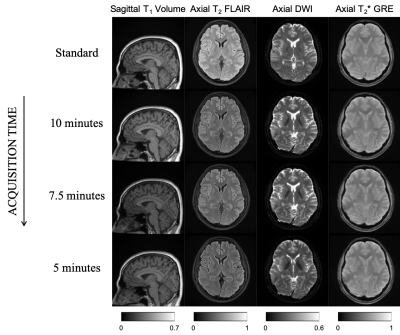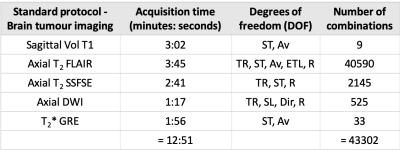Keerthi Sravan Ravi1,2, Sairam Geethanath2, Patrick Quarterman3, Maggie Fung3, and John Thomas Vaughan Jr.2
1Biomedical Engineering, Columbia University, New York, NY, United States, 2Columbia University Magnetic Resonance Research Center, Columbia University, New York, NY, United States, 3GE Healthcare Applied Sciences Laboratory East, New York, NY, United States
1Biomedical Engineering, Columbia University, New York, NY, United States, 2Columbia University Magnetic Resonance Research Center, Columbia University, New York, NY, United States, 3GE Healthcare Applied Sciences Laboratory East, New York, NY, United States
A five-minute intelligent protocol produces 78.25% relative SNR (rSNR) while the standard protocol totalling 12:51 (minutes: seconds) produces 93.75% rSNR. The images from both protocols are similar in contrast.

Figure 4: Single-slice reconstructions of data acquired from a single healthy volunteer across four experiments. Qualitatively, the modified protocol’s contrasts are not significantly different from the standard protocols’ contrast. SNR was allowed to be compromised since it is recoverable post-acquisition by leveraging deep learning methods.

Table 1: The standard brain tumour imaging protocol employed at our center comprises of five pulse sequences totalling an acquisition time of 12:51 (minutes: seconds). Their corresponding acquisition times and chosen degrees of freedom (DOF) are listed. Finally, the number of combinations possible based on the DOF is listed in the last column. ST: slice thickness, Av: averages, TR: repetition time, ETL: echo train length, R: reduction factor, SL: number of slices, Dir: diffusion direction.
